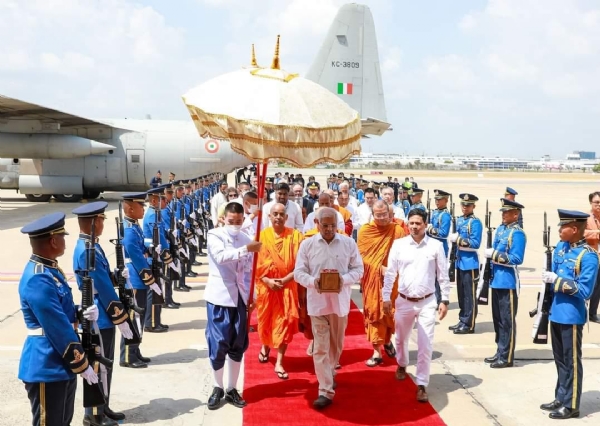Bangkok welcomes Bhagwan Buddha's Relics: Union Minister & Bihar Governor lead delegation for exposition of Siddhartha's relics to Thailand
At the age of 80, in accordance with Buddhist beliefs, Buddha achieved salvation in the Kushinagar district of Uttar Pradesh.
Total Views |
New Delhi, Feb 23: The four Holy Piparahwa Relics of Bhagwan Buddha and his Two Disciples Arahata Sariputra and Arahata Maudgalyayana reached Bangkok, Thailand today for a 26-day exposition along with the 22 member delegation, headed by Governor of Bihar Shri Rajendra Vishwanath Arlekar and Union Minister of Social Justice and Empowerment Dr Virendra Kumar accompanying the sacred relics.

The delegation comprise of venerable monks from Kushinagar, Aurangabad, Ladakh officials from Ministry of Culture, state government of M.P., curators from National Museum, artists and scholars. The event is being organized with the support of Ministry of External Affairs, Indian Embassy in Thailand, International Buddhist Confederation, National Museum, State Government of Madhya Pradesh.
The holy relics were received with great reverence and ceremoniously at the Bangkok Military Airport by the H.E Mr Sermsak Pongpanit, Minister of Culture, Royal Thai Government, Thai officials and a large number of Monks among other dignitaries. The Holy Relics were welcomed with auspicious chanting ceremony and warm hospitality performance at Military Airport.
Embarking on a sacred journey, the Holy Relics of Lord Buddha and his revered disciples, Arahants Sariputta and Mahamoggallana, grace Thailand with their presence after heartfelt ceremonies in New Delhi. #BuddhistHeritage #HistoricVisit #AmritMahotsav
— Ministry of Culture (@MinOfCultureGoI) February 23, 2024
(1/2) pic.twitter.com/ySh4Bw2dwO
Sermsak Pongpanit and Thai officials, along with the Union Minister Dr Virendra Kumar and delegations then conduced the Holy relics from Military Airport to enshrine at the National Museum, Bangkok for safe keeping and later to be enshrined in a grand mandapam prepared in Sanam Luang Pavilion in Bangkok on 23rd February. People can pay their reverence from Makha Bucha Day onwards.
Significance of Buddha's relics
At the age of 80, in accordance with Buddhist beliefs, Buddha achieved salvation in the Kushinagar district of Uttar Pradesh. The Mallas of Kushinagar conducted elaborate ceremonies, treating his cremation with the reverence due to a universal king.
Following the cremation, Buddha's relics from the funeral pyre were carefully gathered and divided into eight portions. These portions were designated for distribution among various groups, including the Ajathsatrus of Magadha, the Licchavis of Vaishali, the Sakyas of Kapilavastu, the Mallas of Kushinagar, the Bullies of Allakappa, the Mallas of Pava, the Koliyas of Ramagrama, and a Brahmana of Vethadipa. The primary objective was to construct stupas to enshrine these sacred relics.
Subsequently, two additional stupas were erected, one commemorating the urn that held the relics and the other honoring the embers. These stupas, known as Saririka stupas, represent the earliest surviving Buddhist shrines constructed over bodily relics of Buddha. Around 272–232 BC, the Emperor Ashoka took a significant step by unveiling seven of the eight stupas and gathering substantial portions of the relics. He then enshrined these relics within the 84,000 stupas he built, aiming to propagate Buddhism and promote the cult of stupas.
--

